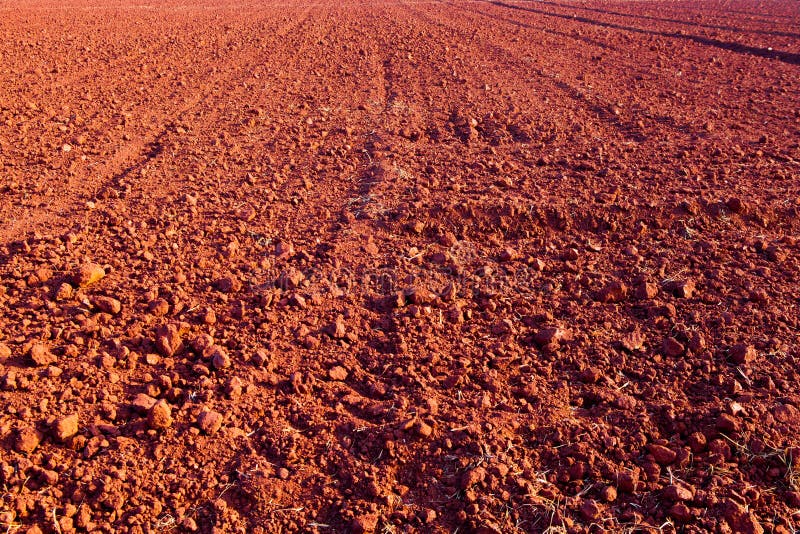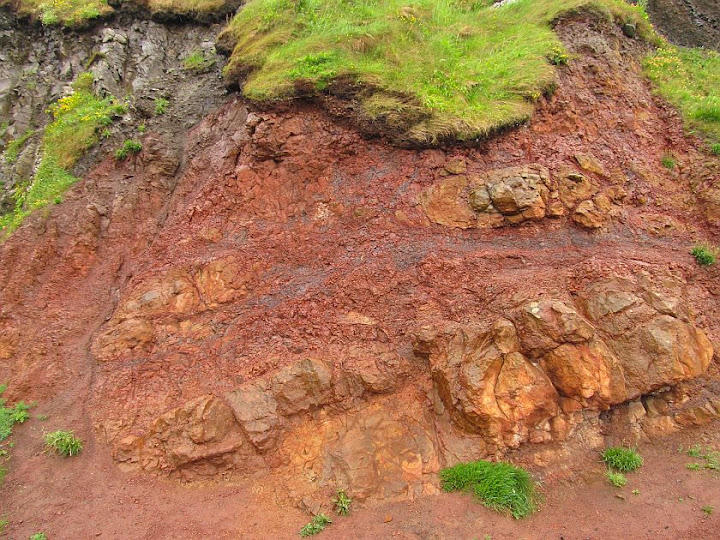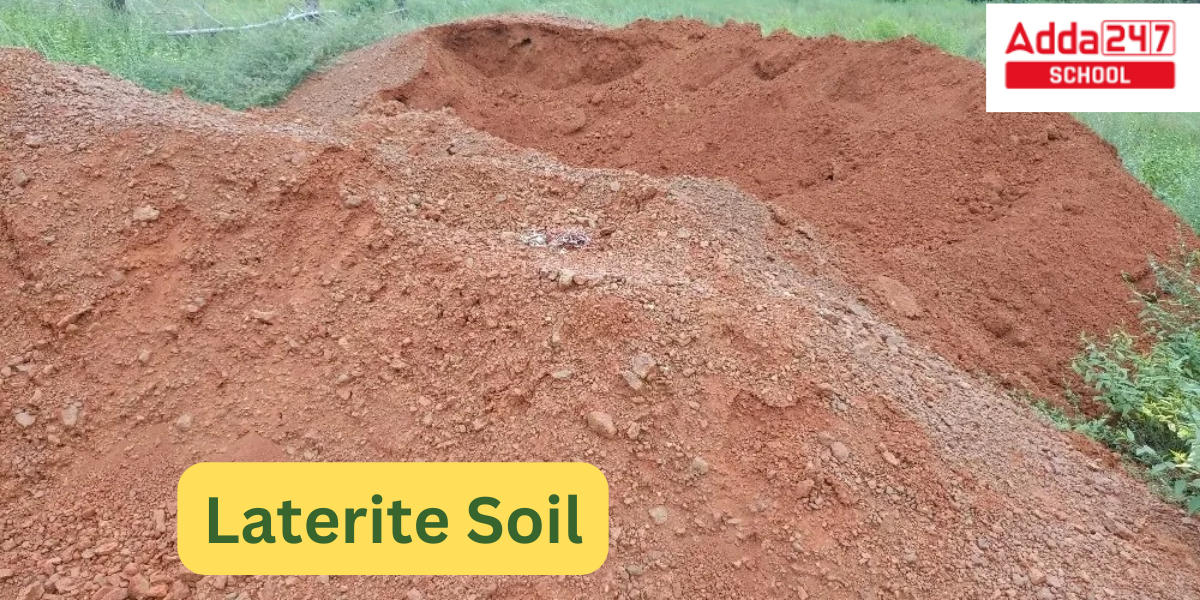Laterite Soil
Laterite is a type of soil and rock formation that is commonly found in tropical regions around the world. It is a unique geological material with distinct characteristics and is widely known for its reddish-brown color. Let’s delve into some informative aspects of laterite:
Formation: Laterite is formed through a process known as weathering, which occurs over long periods of time. The weathering process involves the breakdown of parent rocks, such as basalt, granite, or limestone, due to the effects of heat, moisture, and chemical reactions. The intense tropical climate, abundant rainfall, and high temperatures in these regions contribute to the rapid weathering of rocks, leading to the formation of laterite.
Composition and Appearance: Laterite is primarily composed of iron and aluminum oxides, along with varying amounts of other elements such as silicon, manganese, and titanium. These oxides give laterite its characteristic reddish-brown color, resulting from the presence of iron minerals. The exact composition of laterite can vary depending on the specific geographic location.
What is Laterite Soil?
Characteristics: One of the notable characteristics of laterite is its porosity. The weathering process alters the rock structure, creating a porous material with a honeycomb-like texture. This allows laterite to retain moisture and provides a suitable environment for vegetation in tropical areas, despite the often dry climate.
Uses: Laterite has been utilized by humans for various purposes throughout history. One of its primary uses is in construction. Due to its hardness and durability, laterite is commonly used as a building material for houses, temples, and other structures. It can be easily cut into blocks and shaped to fit specific architectural designs.
In addition to construction, laterite is also used in road construction, especially in areas where it is abundantly available. Its hardness and resistance to erosion make it a suitable material for creating durable and long-lasting roads.
Challenges: While laterite has several advantageous properties, it also presents some challenges. Its hardness makes it difficult to work with using conventional construction techniques. Additionally, the iron content in laterite can cause it to expand and contract with changes in moisture, which can lead to cracks in buildings and infrastructure.
Laterite Soil in India
Laterite Soil is widely believed that hot, humid tropical regions are where laterite, a soil and rock type rich in iron and aluminium, developed. Due to their high iron oxide concentration, nearly all laterites are rusty-red in hue. Laterite Soil forms when parent rock is intensively and repeatedly weathered, typically under conditions of high temperatures, significant rainfall, and alternating wet and dry seasons. Tropical weathering (laterization) is a protracted chemical weathering process that results in a wide range of soil thickness, grade, chemistry, and ore mineralogy. The majority of the terrain that is home to laterites is located between the Cancer and Capricorn tropics.
- Laterite Soil is widely believed that hot, humid tropical regions are where laterite, a soil and rock type rich in iron and aluminium, developed.
- Due to their high iron oxide concentration, nearly all laterites are rusty-red in hue.
- They form when parent rock is intensively and repeatedly weathered, typically under conditions of high temperatures, significant rainfall, and alternating wet and dry seasons.
- Tropical weathering (laterization) is a protracted chemical weathering process that results in a wide range of soil thickness, grade, chemistry, and ore mineralogy.
- The majority of the terrain that is home to laterites is located between the Cancer and Capricorn tropics.
- Both laterite and laterite rocks are frequently used interchangeably.
- There have been suggestions for the name to be completely dropped due to this as well as more variance in the ways that laterite is conceptualised (such as also as a whole weathering profile or theory about weathering).
- At least a few regolith development experts have thought that the name has become the subject of hopeless misunderstanding.
- There is a lot of material that resembles Indian laterite all around the world.
Deccan Plateau in India States, Location and Maps
Laterite Rock
Laterite is a type of soil and rock that is rich in iron and aluminum and is typically found in tropical and subtropical regions. It forms as a result of weathering processes acting on parent rocks, primarily under conditions of high rainfall and temperature. Laterite is often characterized by its distinctive red or brown color due to the presence of iron oxides.
Here are some key characteristics and information about laterite rock:
Formation: Laterite forms through a process called leaching, where heavy rainfall percolates through the soil and carries away soluble minerals, leaving behind the less soluble iron and aluminum oxides. Over time, these oxides accumulate and harden into laterite.
Composition: Laterite contains a significant amount of iron and aluminum, along with other minerals like quartz and kaolinite. The iron content in laterite gives it its reddish-brown color.
Texture: Laterite can have a range of textures, from hard and compact to loose and friable. Its texture often depends on factors such as the degree of weathering, mineral composition, and location.
Uses: Laterite has been historically used as a construction material, particularly in regions where it is abundant. It can be cut into blocks and used for building purposes, such as in constructing houses, temples, and fortifications. It’s known for its durability when dry but can become soft and easily eroded when wet.
Challenges: While laterite can be a useful construction material in some cases, it has limitations. It can be challenging to work with, especially when it’s hard and compact. Additionally, it can expand and contract significantly with changes in moisture, which can lead to structural issues if not properly managed.
Soil Fertility: Lateritic soils, which are derived from laterite rock, may have poor fertility due to leaching of nutrients over time. However, with proper management and fertilization, they can be made suitable for agriculture.
Geological Distribution: Laterite is commonly found in regions with a tropical climate, such as parts of India, Southeast Asia, Africa, and South America. It is also present in some coastal areas.
Erosion: Laterite soils and rocks are susceptible to erosion, especially during heavy rainfall. Erosion can lead to the loss of topsoil and further complicate agricultural practices.
Laterite is a type of rock and soil that forms in tropical and subtropical regions through weathering processes. It is known for its high iron and aluminum content, distinctive color, and historical use in construction. While it has advantages as a building material, it also presents challenges and limitations, particularly in terms of its behavior with moisture and soil fertility.
Laterite Soil Colour and Physical Description in India
Laterite Soil colour and Physical description is given below in points.
- In southern India, Francis Buchanan-Hamilton was the first to identify and characterise a laterite formation in 1807.
- Since this highly compacted and cemented earth is easily cut into brick-shaped building blocks, he dubbed it laterite, which is derived from the Latin word later, which meaning a brick.
- The term “laterite” has been applied to soil horizons with varying degrees of sesquioxide cementation.
- An oxide with three oxygen atoms and two metal atoms is referred to as a sesquioxide.
- Laterite Soil has also been applied to any soil that is reddish near or on the Earth’s surface.

In the stable regions of the Western Ethiopian Shield, on the cratons of the South American Plate, and on the Australian Shield, laterite coverings are thick. The laterite that covers the plateau in Madhya Pradesh, India, is 30 m (100 ft) thick. Laterites come in two different varieties: hard and durable or soft and readily broken into smaller bits. Under the heavy layer of worn rock, basement rocks are rarely visible. The topmost layer of the laterite cover is composed of lateritic soils.
What is the Capital of Arunachal Pradesh?
Laterite Soil Formation Information for Class 10 Students
The Process of Laterite Soil Formation is given below.
- Tropical weathering (laterization) is a protracted chemical weathering process that results in a wide range of soil thickness, grade, chemistry, and ore mineralogy.
- Saprolites, which are essentially kaolinized rocks, are the early byproducts of weathering.
- From around the mid-Tertiary to the mid-Quaternary periods, there was a vigorous laterization period.
- According to statistical calculations, the mean and variance values of 18O abruptly changed in the middle of the Pleistocene. These two shifts suggest a sudden worldwide cooling.
- Laterite Soil appears that this abrupt change was global and mostly represented an increase in ice mass. At around the same time, an abrupt reduction in sea surface temperatures also occurred.

As the planet abruptly cooled, the rate of laterization would have slowed. Weathering in tropical areas is still happening now, but at a slower rate.
Laterite Soil Minerals and Ores
Aluminum ore is found in laterites; it primarily takes the form of clay minerals, hydroxides, gibbsite, boehmite, and diaspore, which shares many chemical properties with bauxite. They used to be a significant source of iron and aluminium ores in Northern Ireland. In the past, laterite ores were another important source of nickel.
Highest waterfall in India, List 2023
Laterite Soil Uses
- Due to their high clay concentration, laterite soils are better able to hold water and exchange cations than sandy soils. Water is trapped between the particles because they are so tiny. Water gently seeps into the soil after it has rained. Laterite soils are less fertile than other soils due to extensive leaching, although they are responsive to manuring and irrigation.
- Laterites are easily cut into standard-sized blocks using a shovel when they are wet. It is wet and squishy because laterite is mined while it is below the water table. The bigger iron salts lock into a strong lattice structure and gradually harden upon exposure to air as the moisture between the flat clay particles evaporates. This makes it resistant to atmospheric conditions.
- In the region of Cambodia, Thailand, and Vietnam, the French used crushed laterite, stone, or gravel to pave the roadways. Kenya and Malawi built test portions of low-volume roads with bituminous surfaces in the middle of the 1970s and the middle of the 1980s, respectively, using laterite as a foundation course in place of stone.
- An important issue in Northern Ireland is the phosphorus enrichment of lakes brought on by agriculture. At a number of sewage treatment facilities, laterite, a low-grade bauxite high in iron and aluminium, is employed in acid solution, followed by precipitation, to remove phosphorus and heavy metals.
List of Districts in India State Wise, Largest and Smallest Districts
Laterite Soil in Tamil
Laterite soil, known as “பருத்தி மண்” (Paruthi Mann) in Tamil, is a type of soil that is commonly found in certain regions of Tamil Nadu and other tropical areas. Laterite soils are characterized by their reddish to brownish color and are formed through the weathering of underlying rocks, particularly those rich in iron and aluminum.
Key characteristics of laterite soil in Tamil Nadu and similar regions include:
Color: The distinctive reddish-brown color of laterite soil is due to the high iron oxide content. This coloration is particularly pronounced when the soil is exposed to air and dries out.
Hardness: Laterite soil can become quite hard and compact when it dries. However, it can also become soft and muddy during the rainy season, making it challenging to work with.
Drainage: Laterite soils often have poor drainage properties, which can lead to waterlogging during heavy rains. This can be a limitation for agriculture.
Fertility: Laterite soils tend to be nutrient-poor and acidic, which can make them less suitable for certain types of crops. They may require extensive soil amendments and fertilization to make them more fertile.
Crop Suitability: Despite their limitations, laterite soils can support certain types of crops, such as cashews, oilseeds, millets, and some fruit trees. Farmers in Tamil Nadu and similar regions often adapt their agricultural practices to the specific characteristics of laterite soils.
Erosion: Due to their compact nature, laterite soils can be susceptible to erosion, especially on sloping terrain. Soil conservation measures may be needed to prevent erosion and degradation.
Common Regions: Laterite soils are prevalent in the hilly and coastal areas of Tamil Nadu, such as the Western Ghats region. They are also found in other parts of South India and in tropical regions around the world.
Farmers and agricultural experts in Tamil Nadu have developed strategies to manage and make productive use of laterite soils, often through soil improvement techniques, crop selection, and irrigation practices that take into account the soil’s characteristics and limitations.
Laterite Soil Meaning in Malayalam
In Malayalam, “laterite soil” is typically referred to as “പാവുകറി” (pronounced as “paavukari”). Laterite soil is a type of soil that is commonly found in tropical and subtropical regions. It is characterized by its reddish-brown to yellowish-red color, which is due to the high iron and aluminum oxide content. Laterite soils are well-drained and often rich in minerals but may be low in fertility and organic matter. They are suitable for certain types of crops and vegetation but may require proper management and fertilization for agriculture.









 Jawahar Navodaya Vidyalaya Admission For...
Jawahar Navodaya Vidyalaya Admission For...
 Karnataka DCET Seat Allotment Result 202...
Karnataka DCET Seat Allotment Result 202...
 AP POLYCET Seat Allotment Result 2025 OU...
AP POLYCET Seat Allotment Result 2025 OU...









